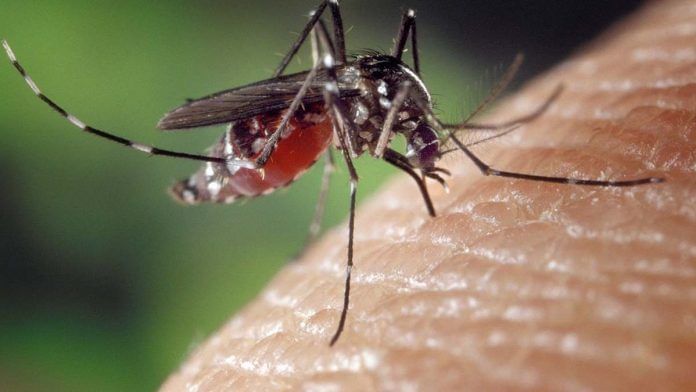New Delhi: India has reported 15 lakh fewer cases in 2018 as against 2017, but it still continues to remain the “highest-burden” country for the mosquito-borne disease, according to a World Malaria Report 2019 released by the World Health Organisation (WHO).
Highest-burden country refers to those nations with the maximum number of malaria cases.
“Despite being the highest-burden country of the region, India showed a reduction in reported cases of 51% compared with 2017 and of 60% compared with 2016,” the report said.
The report, however, also revealed that of the 130 crore people in India, 120 crore are at the risk of acquiring malaria, while 15 lakh are at “high risk”.
While releasing the report Wednesday in Geneva, the WHO hailed India’s efforts to eliminate the deadly disease.
“I am very pleased to note that the two countries — India and Uganda — have reported substantial reductions in malaria cases in 2018 over the previous year,” said Dr Tedros Adhanom Ghebreyesus, director-general, WHO.
The report, however, does not share the figures of malaria cases and deaths.
This report is significant in light of the fact that the Indian government has set a target of making the country malaria-free by 2030.
The health ministry’s National Health Profile data also states that widespread “communicable” diseases such as malaria, kala-azar, dengue, chikungunya are registering a fall in India.
“While we have come a long way, sustained focus and increased funding are crucial to boost India’s fight against malaria and ensure that India continues to lead the world and becomes malaria-free by 2030,” said Dr Sanjeev Gaikwad, country director of Malaria No More India, a non-profit organisation.
Also read: Indians will be infected with malaria, cholera and flu as part of new vaccination trials
India accounted for 58% cases
Out of an estimated 161 crore people in WHO’s South-East Asia region, three countries that accounted for 98 per cent of the total reported cases of malaria are India (58 per cent), followed by Indonesia (30 per cent) and Myanmar (10 per cent).
Globally, countries in sub-Saharan Africa and India carried almost 85 per cent of the global malaria burden.
“Six countries accounted for more than half of all malaria cases worldwide — Nigeria (25%), the Democratic Republic of the Congo (12%), Uganda (5%), and Côte d’Ivoire, Mozambique and Niger (4% each),” the report said.
Malaria scenario across the globe
The rate of malaria cases has declined globally between 2010 and 2018 — from 71 to 57 cases per 1,000 population at risk.
There were an estimated 22.8 crore malaria cases and 4.05 lakh malaria deaths in 2018 globally. “These represent about 29 per cent fewer cases and 60 per cent fewer deaths in 2018 than those in 2000,” according to the report.
In 2018, an estimated 22.8 crore cases of malaria occurred worldwide compared to 25.1 crore cases in 2010.
The African region accounted for the highest number of malaria deaths in 2018, almost 94 per cent — mostly in the regions of Nigeria, the Democratic Republic of the Congo, the United Republic of Tanzania, Angola, Mozambique and Niger.
Most malaria cases in 2018 were in the WHO African Region (93 per cent), followed by the WHO South-East Asia Region (which includes India) at 3.4 per cent of the cases and the WHO Eastern Mediterranean Region (which includes Afghanistan, Iran and Pakistan) at 2.1 per cent.
Also read: Major leprosy, malaria, cardiac drugs to go off shelves as firms want to end Indian supply






